
In this article
- 04
- 05
42.7 million United States households own a cat in 2020. Congratulations on moving the needle by one more household and giving one of the 3.2 million adoptable cats a home.
You’re preparing to bring your furry, bundle of joy home but you’re not sure where to start. With the conflicting information online and the overwhelming number of supplies available for purchase, you have many decisions to make between now and your kitten’s first day at their new home. When you first bring your kitten home you’ll want to ensure the essential items, like bowls and a litter box, are already in place.
You’ll also need to consider what nonessential and medical care will need to be provided for your kitten. But being a good kitten parent doesn’t stop at providing only the best supplies. You’ll also need to learn about kitten-raising and clear up any conflicting advice you’ve received on pet parenthood.
Pet Care Essentials for Kittens

While there are plenty of exciting toys and accessories you’ll want to buy as soon as you decide to adopt a kitten, there are essentials which should be bought before anything else. Food bowls, crates, and cat litter may not be exciting purchases but these items will be necessary and can directly relate to the health of your kitten.
While most kitten essentials are interchangeable with cat products, check every label before purchase to ensure it is safe for use on kittens. There are age recommendations on products like cat food, topical products, and health-related products.
Crates
A cat crate can be used as your kitten’s ‘safe place’ in the house if you don’t have a suitable room to contain them in while you’re away. Crates come in a variety of sizes. If you’re keeping your kitten in a crate during the day while you’re working or sleeping you’ll want to ensure it’s a decently large space.
You want your kitten to have enough room for a litter box, cat bed, roaming space, and a spot for their food and water dishes. Also, check to make sure your kitten isn’t tiny enough to slip through the bars of the crate.
Not everyone needs a crate for their kitten. If you have a bathroom or spare room that is suitable you can save quite a bit of money. Just make sure it is completely kitten-proofed to avoid your kitten injuring themselves or destroying your items.
If you do opt for a crate, here are some options:
- Affordable: AmazonBasics Single-Door & Double-Door Folding Metal Dog Crate
- Luxury: Petsmatig Wire Cat Cage
Travel Carrier
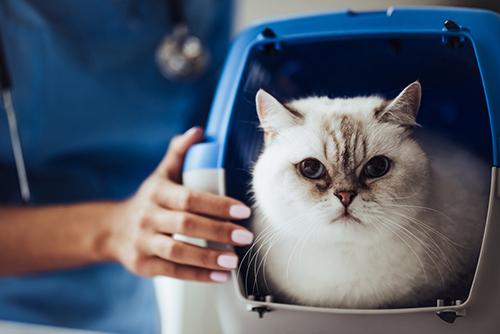
A travel carrier is much different than a crate. Travel carriers are used for transporting your kitten to the vet, play dates, and the groomer if necessary.
You’ll want a crate that is durable and gives your kitten enough room to turn around, but not so much room they will be encouraged to soil the space. Cats aren’t as likely to soil the area where they’re sitting. Some options to pick from include:
- Hard-sided: AmazonBasics Two-Door Top-Load Pet Kennel
- Soft-sided: PetLuv Happy Cat Premium Cat Carrier
Kitten Food
It’s intimidating trying to select one kitten food from all of the products claiming to be the best for your growing pet. Kittens have different dietary needs than their adult counterparts. This means extra protein, vitamins, fats, and minerals.
Pet food is a notoriously touchy topic and everyone holds passionate beliefs about what is best for their pet. Whether you decide to feed wet or dry, here are two options that will provide your kitten with a healthy diet to start their life off right:
Cat Bed
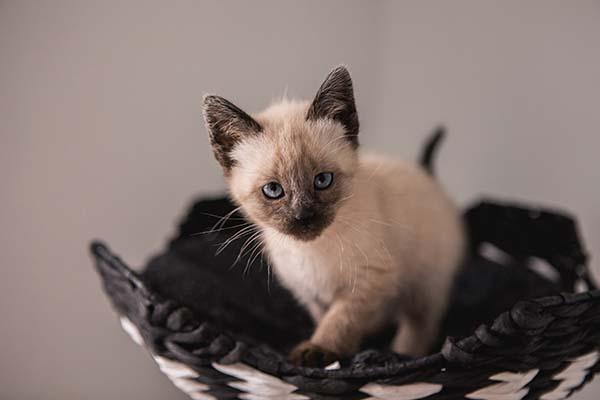
Chances are, your kitten has quite a bit of growing to do. You can start off with a small bed she’ll definitely outgrow or you can pick out a bed designed for a full-grown cat. If you decide to get a bed for a full-grown cat, use a roll of blankets to help make the bed feel more enclosed, cozy, and safe for your tiny kitten. The goal is to make the bed an enticing place for your kitten to call home. This will also keep her off places you may not want her to sleep, like your hamper of clean laundry fresh out of the dryer.
Other factors you’ll want to consider when selecting a cat bed are how washable the material is and if it has a heating feature. You’ll want to regularly wash your cat’s bed to cut out odors and the spread of bacteria. Beds with removable covers are the easiest to clean.
Heating features can also be found in some cat beds either through plugging it in, heating it up in a microwave, or by trapping your cat’s own body heat to promote warmth.
If you’re unsure which bed to go with here are a few options:
- Hollypet Cozy Pet Bed
- Tempcore Cat Bed for Indoor Cats
- Kitty City Cotton Rope Woven Cat Bed
- PAWZ Road Cat Sleeping Bag Self-Warming Kitty Sack
Collar

Kitten collars with a bell are a great way to keep an eye, or rather an ear, on your kitten while they explore their new home. You’ll want to be careful that any collar you buy has a safety breakaway snap. Kittens jump and climb while they play and you don’t want your kitten’s collar to not breakaway if they get caught on something.
Also, check the tightness of the collar daily. Kittens grow fast and you don’t want your kitten’s collar to become too small and begin to cut into their skin.
Check out these collar options for kittens:
- Affordable: SLSON 2 Pack Cat Collars with Bell for Kitten
- Luxury: Pettsie Cat Collar Breakaway Safety with Heart
Food & Water Bowls
Stainless steel and ceramic with a lead-free glaze are the two best materials for kitten food and water dishes. Plastic bowls can be found for fairly cheap but can lead to feline chin acne due to an allergic reaction to the material.
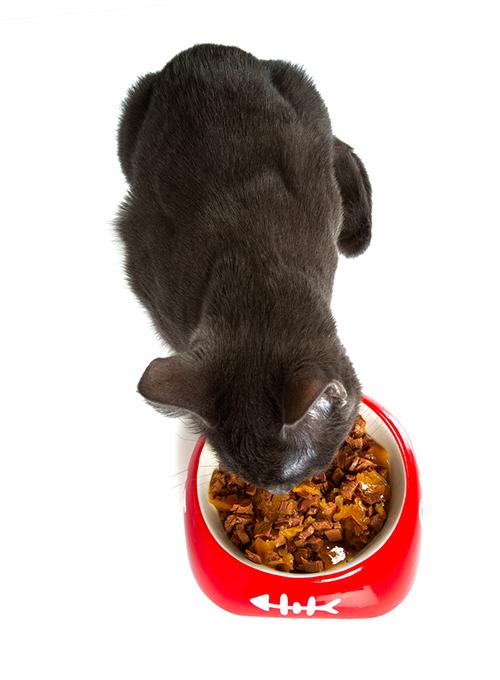
You’ll want to clean your kitten’s bowls daily. Dry food bowls can be run through the dishwasher every few days and rinsed out daily. Wet food bowls should be cleaned daily. Both wet and dry cat food will leave a residue, even if your kitten licks the bowl clean. This is due to the fat content in most pet foods.
Check out these kitten bowls:
ID Tags
If your kitten decides to slip out the door you’ll want to make sure you have everything in place to give you the best chances at getting them back. While you should microchip your kitten as soon as you’re able, having an ID tag on your kitten can help make them quickly and easily identifiable.
It’s wise to include a tag, either separate from the one with your contact information or on the flip-side of it, that denotes your cat as an indoor cat. People are used to seeing cats wander around with and without collars. It doesn’t raise alarm bells as a wandering dog does. By having an “I’m an indoor cat” tag, you can grab the attention of someone who might otherwise ignore your lost kitty.
You should include the following information on your kitten’s ID tag:
- Their name
- Your name
- Your cell phone number
- Your address
Here are some adorable kitten ID tags to consider:
- VeehooDidog Personalized Cat ID Tags Pet ID Tags
- Didog Personalized Cat ID Tags
- GoTags Funny (Indoor Only Cat Tag)
- FURBB Cat ID Tags
Have Your Kitten Microchipped
Schedule an appointment to have your kitten microchipped.
Litter Box & Litter
Litter boxes may not be the most exciting shopping item on your list but they are at the top of the list for kitten necessities. You’ll need to find a shallow pan to start your kitten out with as they’ll have a difficult time stepping over the higher edges of many litter pans available on pet stores.
You’ll also need to find a kitten litter that is safe for use. Avoid clumping litters until your kitten is older as these can cause blockages if ingested. It’s best to use non-clumping or pelleted litter until your kitten is older.
Litter Training Your Kitten
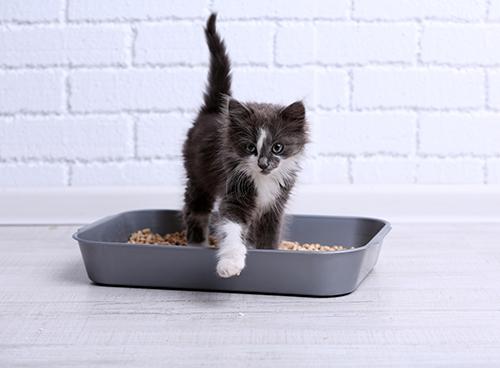
There’s great news for new kitten parents. Unlike with puppies, kittens practically potty train themselves. Kittens naturally understand the concept of the litter box.
You can begin introducing your kitten to the litter box at around three weeks. This is when kittens begin to no longer need stimulating to go to the bathroom.
Place the litter box in a corner of their space and clean it throughout the day, at the very least once daily. Then, each time your kitten uses their litter box, praise them profusely to encourage the good habit. You’ll be surprised how simple it is to convince your kitten the litter box is the place to go.
Flea Comb & Brush
Having a flea comb and regular grooming brush on hand will encourage you to spend time grooming your kitten regularly. This will benefit both of you by offering time to bond, giving you the ability to check for parasites, and getting your kitten used to further handling.
Long-haired cats and kittens need short, daily grooming sessions. Short-haired felines, on the other hand, can get away with one grooming session a week. Check out these two grooming kit pieces:
Nail Trimmers
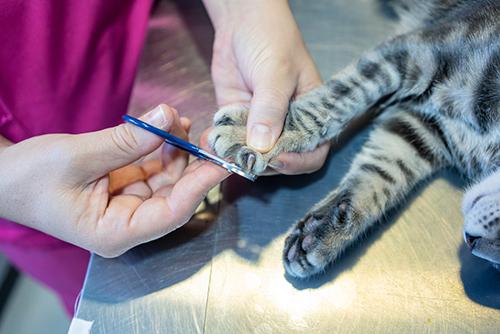
Keeping your kitten’s nails in check will help deter scratching up carpet and furniture. It will also keep your kitten from accidentally scratching you during playtime. While your kitten’s claws will be tiny until she grows older, it’s best to get her adjusted to nail trimming from an early age. It’s best if you learn how to do this from home as it can be more stressful to transport your kitty to the vet for nail clippings.
Check out these nail clippers for cats and kittens. If you plan to regularly clip your cat’s nails we recommend investing in the luxury option as the clippers more easily cut through thicker adult cat nails.
- Affordable: JW Pet Company GripSoft Cat Nail Clipper
- Luxury: JOFUYU Updated 2020 Version Cat Nail Clippers and Trimmer
Medical Milestones to Follow the First Year

Start your kitten’s life off right by hitting all the medical milestones with prompt veterinary care. You’ll want to make sure you address any health concerns you’ve noticed with your kitten. The first year of veterinary care consists of vaccinations, flea and heartworm prevention, and having your kitten spayed or neutered. You should also decide if you’d like to have your kitten declawed. This is a decision you’ll want to have with your vet and determine earlier on as there can be complications associated with waiting to declaw.
Book Your Kitten’s First Appointment
Schedule your kitten’s very first vet appointment with our expert team.
Vaccinations
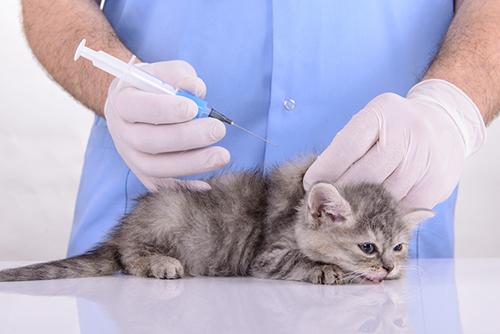
Cat vaccinations are important even for indoor cats as you never know when your cat will slip out or encounter another feline. Many of the diseases cats can pick up can result in shortened lifespans, something all pet owners would rather avoid. Besides the rabies vaccine, which is required by law, your kitten will also receive vaccines that guard against rhinotracheitis, calicivirus, herpes, feline leukemia, feline distemper, and chlamydia.
Heartworm Prevention
Cats are atypical hosts for heartworms. While heartworms won’t necessarily survive to adulthood, they can still be detrimental to your cat’s health. Heartworms can cause a condition known as HARD (heartworm associated respiratory disease).
Prevention will be the only way you can protect your kitten from contracting heartworms at any point in their lives. While dogs can be treated for heartworms, an equivalent treatment is not available for cats.
You should start your kitten on a heartworm preventative no later than eight weeks of age or as early as the label allows.
Flea Prevention
Currently, the only two ingredients labeled as ‘safe’ for kittens under eight weeks to treat fleas are nitenpyram and lufenuron. If your kitten is too young for the flea treatments available for you, your other option is to provide a flea bath with a gentle detergent, using a flea comb, and treating the environment where your kitten lives.
Talk to your veterinarian about any concerns you have. Your vet will be able to provide you with the best prevention plan for your kitten’s age and size.
Spay or Neuter
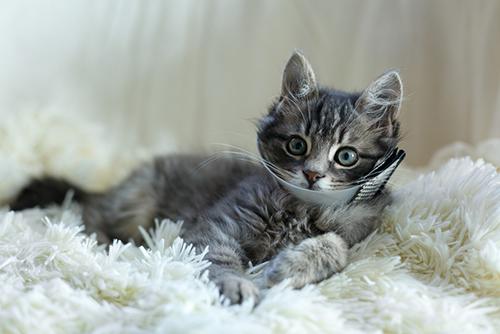
You can have your kitten spayed or neutered starting at four months. Female kittens reach sexual maturity at four months and male kittens at five months. To avoid any accidents you’ll want to get your kitten fixed as soon as possible.
Some owners find they are hesitant to have their pet altered but it provides a wealth of benefits for both you and your cat:
- Boost life expectancy
- Eliminates risk of infection in the uterus
- Reduces chances of cancer in the reproductive system
- Diminishes your pet’s desire to wander
You’ll want to talk to your vet about any questions or concerns you have and to determine the right time.
Accessories & Extras You’ll Want for Your New Kitten
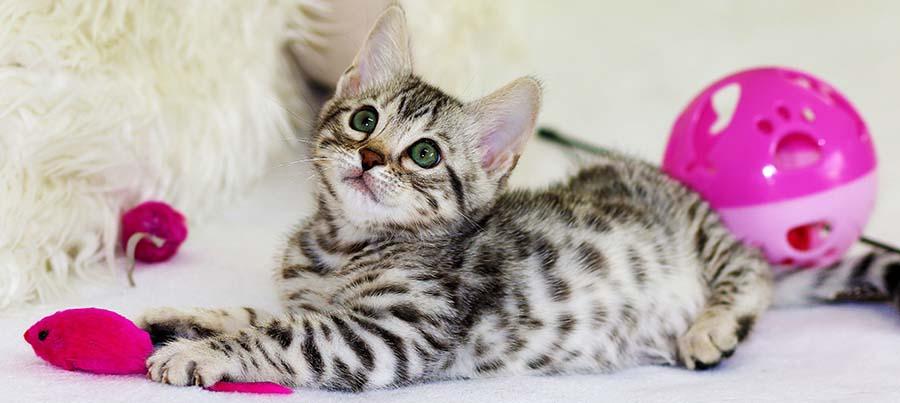
Litter and cat food isn’t nearly as exciting as showering your new kitten with toys and treats. Mental stimulation is a must for keeping your indoor kitten active and happy.
If you’ve spent your entire budget on kitten care essentials you can make affordable cat toys with cardboard boxes, paper bags, and put treats into a cardboard roll.
Kitten Toys
Keeping your kitten entertained while you’re away is important to keep them calm and lean as they grow up. You can use automatic cat toys and puzzle toys to keep them entertained.
It’s important you change your kitten’s toys to keep them from losing interest or becoming bored. With the rise of the pet care industry, cat subscription boxes have been popping up.You can try out options like the meowbox or KitNipBox for an assortment of toys and treats.
If you’d rather handpick your kitten’s toys, try out the following toys your kitten is sure to love:
(Interactive)
Scratching Post
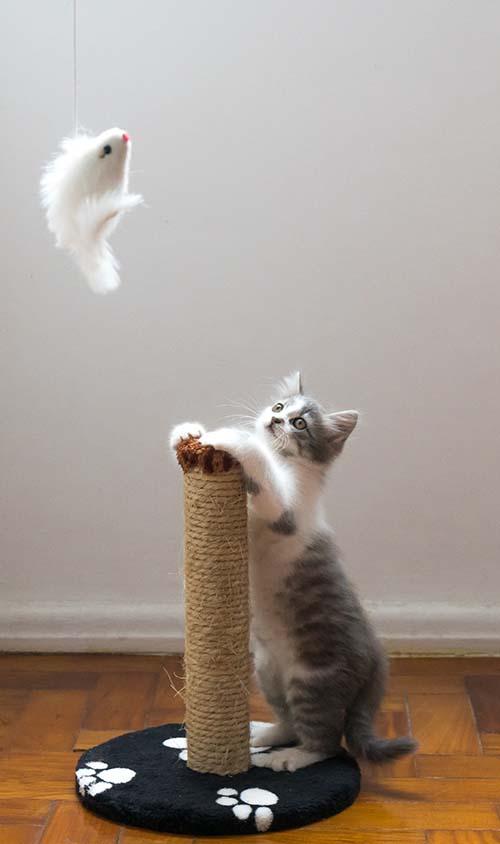
Scratching posts and opportunities to climb will keep your kitten entertained, fit, and off of your own furniture. You might think your kitten is just being rowdy when they take their claws to your brand new chair, but kittens do benefit in multiple ways by scratching:
- Full body stretching
- Shedding nail layers for healthier claws
- Communication with other cats in house via scent glands in their paws
- Relieves stress
Provide your kitten a cat tree, scratching post, cat scratching mat, or all three to keep them occupied and away from ruining your furniture. Here are a few you let your kitten try out:
Treats
Treats are a fun way to reward and bond with your kitten. But in excess, they can cause health problems and result in other negative side effects.
When considering treats for your kitten, keep in mind they should never exceed more than 10% of your kitten’s daily caloric intake. In a ten-pound cat that could be as little as 20 to 25 calories worth of treats daily. Now consider how tiny your kitten is. She’ll need significantly fewer calories from treats each day.
You’ll want to look for treats that are fully cooked and low in calories when deciding what you give your kitten. Also know that cats can’t taste sugar. You should avoid any sugary treats as it doesn’t mimic what cats would consume in a natural diet.
As your kitten grows older you can turn to catnip as a great low calorie, green alternative to other readily available cat treat options. Here are a few you can test out:
Extras to Keep in Mind Before You Bring Your New Kitten Home
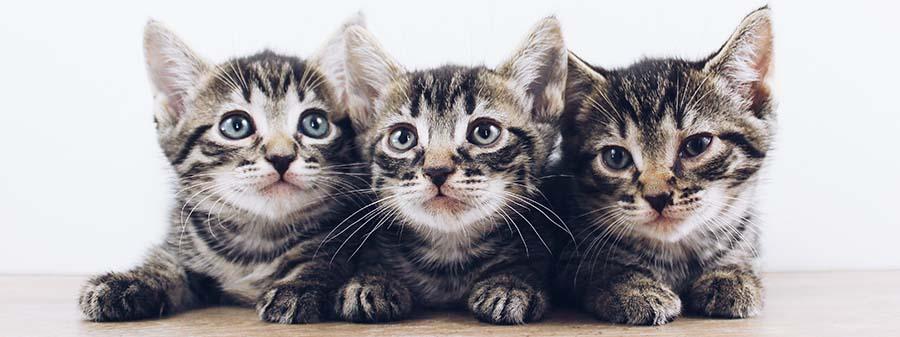
Kitten care isn’t only about providing the best accessories and products, you’ll also want to make sure you’re creating the best environment. While kittens are normally considered ‘low-maintenance’ in comparison to puppies, there’s more to consider than you think.
Kitten-Proofing Your Home
Kittens are playful, curious and sometimes destructive. Curb any bad habits and situations before they start by kitten-proofing at least one room out of your home. As your kitten gets older and begins to explore more of your house unsupervised, you’ll want to expand your kitten-proofing to the entire home. Here’s how:
- Put away breakable items
- Move important items from shelves and countertops
- Assess your home and remove any dangling objects
- Remove poisonous plants
- Install childproof latches on cabinets and drawers
- Always keep the toilet lid down
- Secure all medication in a locked door or cabinet
Kitten Socializing Best Practices
Part of your job as a kitten parent is to help them experience new situations and become comfortable in varied environments. This can help make vet trips or finding them if they become lost much easier.
The primary window of opportunity when kittens are most receptive to new experiences range from two weeks up to fourteen weeks. As most owners don’t bring their kitten home till they are eight weeks old, this means you’re working with a time budget.
Find time to help you kitten experience the following situations:
- Meeting other animals (dogs, cats, bird, etc.)
- Visiting a veterinary office
- Going on a car ride
- Being around different home devices (vacuum, dishwasher, etc.)
- Being in a crate or carrier
- People besides members of your household
- Being brushed or groomed
- Being bathed
- Having their nails trimmed
- Handling their ears
- Being held
Don’t give up on socializing your kitten, even if you don’t get everything before they hit fourteen weeks. Time and effort can help your growing kitten become used to a variety of scenarios no matter their age.
Multi-Kitten Households
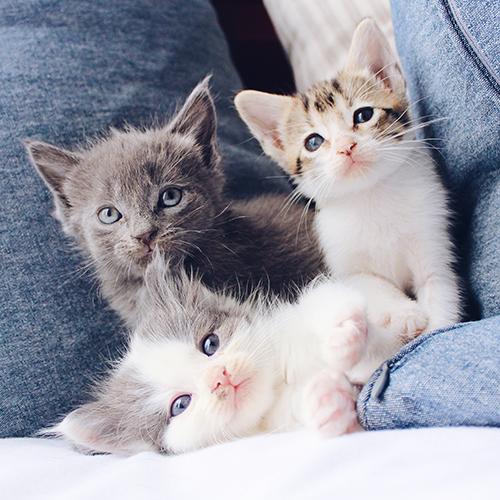
You’ll notice many kitten adoption agencies and shelters offering two kittens for the cost of one adoption fee. Sure, it’s partially due to overpopulation and the hope of getting more felines into loving homes. But, there’s also a behavioral and emotional benefit to your kitten having a buddy from day one.
Kittens experience the following benefits when they live in pairs:
- Focusing play aggression to one another
- Learning via observation of the other
- Enriched and entertained from companionship
- More easily introduce pairs to preexisting pets
- Easier to pair cats as kittens rather than wait
If you’re considering just one kitten and don’t currently have any cats at home, it’s time to take a step back and consider bringing home two if you have the time and financial means. (Note: Always consider finances and your ability to provide proper medical care for any animal you bring home.)
Frequently Asked Questions for Concerned New Kitten Parents

Cats are known for being self-sufficient companions. But while your kitten will grow into an independent roommate, they don’t start off that way. Your kitten will need plenty of guidance and supervision to keep them safe while they get through their first few months of life.
How Long Until Your Kitten Adjusts to Their New Home?

Given your kitten has no social problems or previous trauma, they should adjust to their new home within seven to fourteen days. You’ll want to take any measure you can to help your kitten adjust by making their space feel secure and comfortable. If your kitten continues to be skittish or lash out then it may be time to talk to a specialist.
Where Should Your Kitten Sleep at Night?
You’ll want to provide a cozy bed with high sides to help your kitten feel safe. You can place a rolled-up blanket in a larger cat bed to help give them a secure feeling.
While kittens sleep a lot (about 20 hours a day), there will be times when you can’t supervise them. Kittens are known for being curious but you won’t want to test out the nine lives tale by leaving them unoccupied for too long.
If you’re going to be out of your home or sleeping, it’s best to place your kitten in a kitten-proofed room of your home or in a large crate. This will give them the space to access water and a litter box but not too much space that they can get into trouble.
Can I Give My Kitten Catnip?
It is perfectly safe to let your kitten try out catnip. Giving your feline friend a bit of catnip can unleash a side of their personality you’ve never seen, especially if they are one of the 50% of cats who have a hyperactivity reaction to the herb. If your cat falls into the other 50% of cats they will only exhibit a calm and relaxed mood when smelling or ingesting it.
While you may be excited to let your kitten try out catnip, you’ll find yourself disappointed by their reaction if your kitten is younger than three months old. Kittens only develop the ability to react to catnip somewhere between three and six months of age.
How Should You Introduce Your Kitten to Other Family Pets?
If your new kitten isn’t the first animal to call your house home you’ll have some introductions to make. A new home and a new housemate can be stressful for all parties involved. Make sure you make these introductions gradually and with special attention given to the reactions of each animal.
While the instructions below are approximations of introducing animals, you’ll need to use your best judgment. Animal personalities vary just as much as human personalities. Some cats, especially shy ones, will do better with an expedited introduction process.
Kittens to Cats
You’ll want your kitten and cat to meet one another through smell alone at first. This can be done by allowing them, free of will, to sniff one another from under the door where your kitten’s ‘safe room’ is situated. After a few days of allowing them to meet one another through scent, you can begin exchanging their bedding daily to further introduce the two.
Now, as long as there are no signs of aggression, the roles will reverse. Let your kitten out of their room for a few hours each day while your cat goes back into the kitten-proofed room. From here you will allow them to finally meet through sight. This can be arranged by placing the kitten in a carrier or crate where the cat can greet them. You’ll want to do this in short burst multiple times a day until the cats appear to be comfortable and no signs of aggression are shown.
Finally, allow cat and kitten to meet face-to-face at their own pace by leaving the door to the kitten-proofed room open. Ensure their time together is always supervised and watch for any signs of aggression. You will notice over the coming months, and likely for years following that, your cats may occasionally hiss and swat at one another. This is completely normal as cats are constantly affirming the pecking order of their territory. Your job as an owner is to make sure their squabbles don’t escalate into full-fledged, potentially damaging fights.
Kittens to Dogs
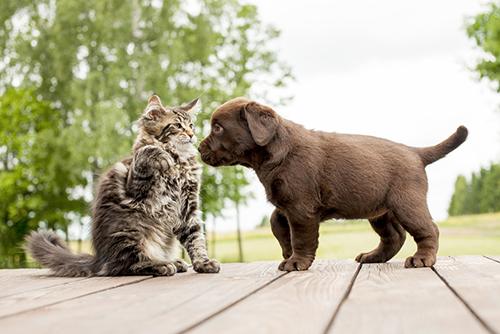
You’ll introduce your dog and kitten using many of the same techniques you would if you were introducing a kitten and cat. You’ll want to start by refreshing your dog’s obedience skills before bringing your kitten alone. Focusing on commands like ‘come’ and ‘leave it’, will help you when they’re overly excited about the new housemate you’ve just brought home.
Once your kitten is home, start by keeping your kitten separated in their kitten-proof room. Focus on dispersing both kitten and dog’s scents around the other’s area of the home. This is most easily done by exchanging bedding. Having the other’s scent in their own territory prior to meeting face-to-face will help each animal become accustomed to and accepting of the other.
Next, you can introduce the two using a baby gate as a barrier. Walk your dog by the baby gate multiple times a day, rewarding each pet for good behavior. Move at your kitten’s pace and level of comfortability.
Finally, when you feel kitten and dog are ready to truly meet, let them greet one another in an open, neutral place in the home. Ensure your dog is on a leash and your kitten is able to easily run and hide if they become scared. All meetings should be completely supervised until both parties seem completely relaxed around one another. This could take time, and that’s okay!
Be patient and keep working at it. Some housemates never become best friends, but in time they will learn to accept and live together.
Have a kitten-specific item you can’t live without? Leave it in the comments below!
Book Your Kitten’s First Appointment
Schedule your kitten’s very first vet appointment with our expert team.

